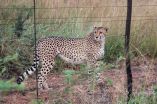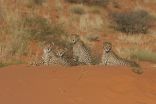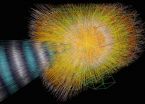(Press-News.org) Wild cheetah populations have declined precipitously in the past century: from an estimated 100,000 in 1900 to only around 10,000 today. A new study from researchers in Europe, South Africa and at North Carolina State University suggests that the energy cheetahs spend looking for prey, rather than their high-speed hunting tactics or food stolen by other predators, may be to blame for their dwindling numbers.
Cheetahs are high-speed hunters, but are not the strongest predators in their ecosystems. Often, hyenas and lions will take advantage of this, stealing the cheetah's hard-won meal. Researchers had surmised that regular prey loss to theft might be weakening the animals, by forcing them to expend energy on chasing and taking down prey that they couldn't replace. An international team of biologists decided to look at whether or not this was the case.
The researchers captured cheetahs from two different South African reserves, injected them with a special type of isotope-laden water, and put radio collars on the animals. By following the cheetahs and analyzing the amount of isotope in their waste samples, they were able to calculate how much energy a cheetah used to catch prey, and thus, how damaging prey theft would be.
The results were surprising. The cheetah's energy expenditure during an actual hunt was relatively small, even taking into account their bursts of speed. The biggest driver of energy expenditure for cheetahs turned out to be the distance they had to walk in order to find their prey.
"It seems that the cheetah is able to cope with larger predators and the occasional loss of food without too much difficulty," says Mike Scantlebury, biologist at Queen's University in Belfast, Northern Ireland and lead author of the paper describing the research. "For prey theft to be a factor, cheetahs would have to have their meal stolen over 50 percent of the time, which is not the case with the animals we studied."
Instead, the researchers link the cheetah's decline to factors – including habitat loss and human involvement – that force cheetahs to travel farther in search of prey.
According to Johnny Wilson, who worked on the project while completing his Ph.D. at NC State, "We too often blame lions and hyenas for decimating cheetah populations when in fact it is likely to be us who drive their declines. Anything that we do to make them move farther to find prey – like depleting their prey stocks or erecting fences or barriers – makes life a lot harder for a cheetah."
The researchers' work appears in Science.
INFORMATION:
Note to editors: Abstract follows.
"Flexible energetics of cheetah hunting strategies provide resistance against kleptoparasitism"
DOI: 10.1126/science.1256424
Authors: David M. Scantlebury, Nikki J. Marks, Queen's University Belfast, Northern Ireland; Michael G. L. Mills, Margaret E. J. Mills, The Lewis Foundation, South Africa; Rory P. Wilson, Swansea University, United Kingdom; John W. Wilson, North Carolina State University; Sarah M. Durant, Zoological Society of London; Nigel C. Bennett, University of Pretoria, South Africa; Peter Bradford, Global Vision International, South Africa; John R. Speakman, University of Aberdeen, Scotland and Chinese Academy of Sciences, Beijing, China.
Published: Oct. 2, 2014 in Science
Abstract:
Population viability is driven by individual survival, which in turn depends on individuals balancing energy budgets. As carnivores may function close to maximum sustained power outputs, decreased food availability or increased activity may render some populations energetically vulnerable. Prey theft may compromise energetic budgets of mesopredators, such as cheetahs and wild dogs, which are susceptible to competition from larger carnivores. We show that daily energy expenditure (DEE) of cheetahs was similar to size-based predictions and positively related to distance traveled. Theft at 25% only requires cheetahs to hunt for an extra 1.1 hour per day, increasing DEE by just 12%. Therefore, not all mesopredators are energetically constrained by direct competition. Other factors that increase DEE, such as those that increase travel, may be more important for population viability.
Cheetahs never prosper: Energy expenditure linked to population decline
2014-10-02
ELSE PRESS RELEASES FROM THIS DATE:
Princeton scientists observe elusive particle that is its own antiparticle
2014-10-02
VIDEO:
Princeton University researchers first deposited iron atoms onto a lead surface to create an atomically thin wire. They then used a scanning-tunneling microscope to create a magnetic field and to...
Click here for more information.
Princeton University scientists have observed an exotic particle that behaves simultaneously like matter and antimatter, a feat of math and engineering that could yield powerful computers based on quantum mechanics.
Using a two-story-tall microscope ...
HIV pandemic's origins located
2014-10-02
The HIV pandemic with us today is almost certain to have begun its global spread from Kinshasa, the capital of the Democratic Republic of the Congo (DRC), according to a new study.
An international team, led by Oxford University and University of Leuven scientists, has reconstructed the genetic history of the HIV-1 group M pandemic, the event that saw HIV spread across the African continent and around the world, and concluded that it originated in Kinshasa. The team's analysis suggests that the common ancestor of group M is highly likely to have emerged in Kinshasa around ...
New map exposes previously unseen details of seafloor
2014-10-02
Accessing two previously untapped streams of satellite data, scientists at Scripps Institution of Oceanography at UC San Diego and their colleagues have created a new map of the world's seafloor, creating a much more vivid picture of the structures that make up the deepest, least-explored parts of the ocean. Thousands of previously uncharted mountains rising from the seafloor and new clues about the formation of the continents have emerged through the new map, which is twice as accurate as the previous version produced nearly 20 years ago.
Developed using a scientific ...
New study suggests humans to blame for plummeting numbers of cheetahs
2014-10-02
A new study led by Queen's University Belfast into how cheetahs burn energy suggests that human activity, rather than larger predators, may force them to expend more energy and thus be the major cause of their decline.
Wild cheetahs are down to under 10,000 from 100,000 a century ago with conventional wisdom blaming bigger predators for monopolising available food as their habitat becomes restricted. The traditional thinking has been that cheetahs no longer have sufficient access to prey to fuel their enormous energy output when engaging in super-fast chases.
But, ...
New approach to boosting biofuel production
2014-10-02
CAMBRIDGE, MA -- Yeast are commonly used to transform corn and other plant materials into biofuels such as ethanol. However, large concentrations of ethanol can be toxic to yeast, which has limited the production capacity of many yeast strains used in industry.
"Toxicity is probably the single most important problem in cost-effective biofuels production," says Gregory Stephanopoulos, the Willard Henry Dow Professor of Chemical Engineering at MIT.
Now Stephanopoulos and colleagues at MIT and the Whitehead Institute for Biomedical Research have identified a new way to ...
Falling asleep: Revealing the point of transition
2014-10-02
How can we tell when someone has fallen asleep? To answer this question, scientists at Massachusetts General Hospital have developed a new statistical method and behavioural task to track the dynamic process of falling asleep.
Dr Michael Prerau, Dr Patrick Purdon, and their colleagues used the evolution of brain activity, behaviour, and other physiological signals during the sleep onset process to automatically track the continuous changes in wakefulness experienced as a subject falls asleep.
The study, publishing today in PLOS Computational Biology, suggests that it ...
Researchers identify new pathway linking the brain to high blood pressure
2014-10-02
VIDEO:
Dr. Frans Leenen, from the University of Ottawa Heart Institute, discusses the importance of these new findings.
Click here for more information.
Ottawa, ON and Baltimore, MD, October 2, 2014—New research by scientists at the Ottawa Heart Institute and the University of Maryland School of Medicine (UM SOM) has uncovered a new pathway by which the brain uses an unusual steroid to control blood pressure. The study, which also suggests new approaches for treating high blood ...
York academics reveal new findings about insect diversification
2014-10-02
Biologists from the University of York have compiled two new datasets on insect evolution, revealing that metamorphosing insects diversify more quickly than other insects and are therefore the biggest contributors to the evolution of insect diversity.
Both funded by the Natural Environment Research Council (NERC), the first dataset is a complete fossil catalogue showing timescales of origination and extinction of different families of insects. Working with the Natural History Museum and National Museums Scotland, former PhD student Dr David Nicholson collated a database ...
A closer look at the perfect fluid
2014-10-02
By combining data from two high-energy accelerators, nuclear scientists have refined the measurement of a remarkable property of exotic matter known as quark-gluon plasma. The findings reveal new aspects of the ultra-hot, "perfect fluid" that give clues to the state of the young universe just microseconds after the big bang.
The multi-institutional team known as the JET Collaboration, led by researchers at the U.S. Department of Energy's Lawrence Berkeley National Lab (Berkeley Lab), published their results in a recent issue of Physical Review C. The JET Collaboration ...
Supreme delay: Why the nation's highest court puts off big decisions until the last moment
2014-10-02
As the Supreme Court of the United States begins its fall 2014 session this month, it faces decisions on several "blockbuster" cases, including freedom of speech, religious freedoms in prison, pregnancy discrimination and a possible decision on gay marriage.
Just don't expect any of these decisions until next June, just before the court's session ends.
New research from the Washington University in St. Louis School of Law finds big, or "blockbuster," cases are disproportionately decided at the end of June, just before the court's summer recess.
"We knew that more than ...




